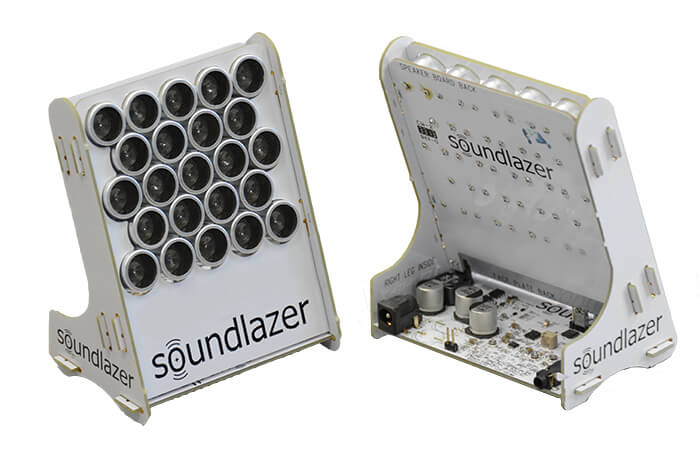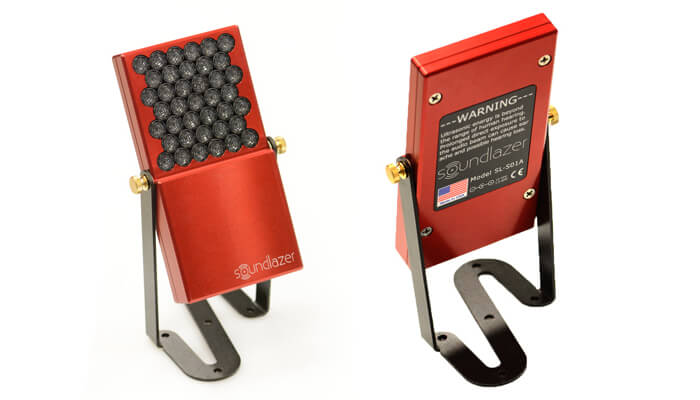Being able to direct sound is useful in many situations. Two examples are at a museum where people standing in front of two different exhibits can hear two different commentaries or at home if you don’t want to hear the crap someone else listens to.
This is where modulated ultrasound comes to the rescue – the ability to direct sound with an impressive 5 – 10° spread – that’s unheard of with any traditional loudspeaker.

Lets take a quick look at how this craziness works because it’s not your typical transducer, that’s for sure.
In a typical loudspeaker the transducer (a device which coverts energy from one form to another) is an electromagnetic coil attached to a paper cone which resonates at the frequency of the audio it is producing. In other words, it causes air particles to vibrate at all the necessary frequencies needed to create the output audio.
This method typically has a very wide dispersal angle, albeit narrower for high frequencies and wider for low frequencies. You often hear people claiming, for example, that subwoofers are not directional. Although that claim is not exactly true it does help understand how you can achieve directional audio with ultrasound – using a very high frequency carrier (around 65KHz) to direct the sound where you want it.
For many years the solution for directional audio has been to use ‘phased arrays’ – essentially you offset the phase of parts of the source so that they sum towards the intended target. Although these work for short distances they are generally ineffective for anything outside the focal length.
A company called ‘Holosonics’ was formed by an MIT professor, who was once the youngest acoustic engineer at Bose. They own the patents for several techniques used in the ‘sound from ultrasound’ method and because of this are the main players, for now at least. Their product, the ‘Audio Spotlight’ uses modulated ultrasound to act as the carrier for the underlaying audio signal. To quote from wikipedia:
A transducer can be made to project a narrow beam of modulated ultrasound that is powerful enough, at 100 to 110 dBSPL, to substantially change the speed of sound in the air that it passes through. The air within the beam behaves nonlinearly and extracts the modulation signal from the ultrasound, resulting in sound that can be heard only along the path of the beam, or that appears to radiate from any surface that the beam strikes.
In other words, they fire out a beam of ultrasound (which is directional, given its high frequency, low wavelength) and they magically modulate the actual audio within it. The audio you hear is then demodulated when it hits a surface. Because it uses such high frequencies as the carrier, it means the beam is susceptible to being interrupted – by almost anything. Therefore for this technology to work there needs to be free air between the source and the destination. Mounting speakers in the ceiling is one such method to achieve this.
Another term for this is a ‘parametric speaker’ and indeed there was a kickstart project to create an opensource alternative to the Audio Spotlight – it’s called the ‘SoundLazer’.
The original project looked like the first image and the final product is underneath.


Their product seems to achieve very similar results to the commercial alternative, claiming two people can literally be a few feet apart and be completely isolated.
Because of the way these systems work you can’t use a normal amplifier, not least because an audio amplifier isn’t designed to deal with high frequency ultrasound. Therefore it does get a bit pricey.
Looking at the SoundLazer website you can get a parametric array and amplifier for around £350, which when you think about isn’t that bad at all.
I’m a sucker for Kickstarter and OpenSource and despite whatever patents ‘Holosonics’ may currently hold it’s not stopping the SoundLazer guys from producing their own.
Check out their online shop: http://www.soundlazer.com/shop/
There’s also a handy video on youtube which explains the principles very well. If a picture can paint a thousands words then a video can paint a million – am I right?